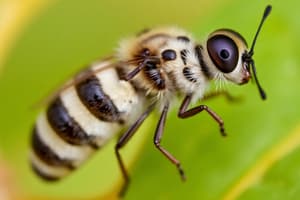Podcast
Questions and Answers
Which of the following represents the correct way to write a scientific name?
Which of the following represents the correct way to write a scientific name?
- QUERCUS RUBRA
- Quercus rubra (correct)
- Quercus Rubra
- _quercus rubra_
Which sequence accurately depicts the arrangement of taxa from the most inclusive to the least inclusive, without omitting any levels?
Which sequence accurately depicts the arrangement of taxa from the most inclusive to the least inclusive, without omitting any levels?
- Kingdom-order-class-phylum
- Kingdom-phylum-class-order (correct)
- Domain-kingdom-family-genus
- Kingdom-phylum-order-family
What is the system of assigning two-part scientific names to organisms called?
What is the system of assigning two-part scientific names to organisms called?
- Taxonomic classification
- Phylogenetic nomenclature
- Hierarchical taxonomy
- Binomial nomenclature (correct)
Which characteristic is shared by organisms in the kingdoms Protista, Plantae, Fungi, and Animalia?
Which characteristic is shared by organisms in the kingdoms Protista, Plantae, Fungi, and Animalia?
In the scientific name Ursus maritimus, what does the first word 'Ursus' refer to?
In the scientific name Ursus maritimus, what does the first word 'Ursus' refer to?
Why might a single organism have different common names in different regions?
Why might a single organism have different common names in different regions?
What is the primary basis for differentiation of bacteria using the Gram stain technique?
What is the primary basis for differentiation of bacteria using the Gram stain technique?
Which type of organism obtains energy by oxidizing reduced inorganic compounds?
Which type of organism obtains energy by oxidizing reduced inorganic compounds?
Which characteristic listed below is NOT applicable to viruses?
Which characteristic listed below is NOT applicable to viruses?
What is the nature of a bacterial plasmid?
What is the nature of a bacterial plasmid?
Which process is primarily responsible for reproduction in bacteria?
Which process is primarily responsible for reproduction in bacteria?
What metabolic role do most bacteria fulfill in ecosystems?
What metabolic role do most bacteria fulfill in ecosystems?
Amoebas, foraminiferans, radiolarians and heliozoans are classified into which group?
Amoebas, foraminiferans, radiolarians and heliozoans are classified into which group?
What collective term describes single-celled photosynthetic protists, such as euglenoids, chrysophytes and dinoflagellates, found in aquatic habitats?
What collective term describes single-celled photosynthetic protists, such as euglenoids, chrysophytes and dinoflagellates, found in aquatic habitats?
What is the primary use of diatomaceous earth?
What is the primary use of diatomaceous earth?
What is the common name for Macrocystis found off the coast of California?
What is the common name for Macrocystis found off the coast of California?
What major feature helps classify protozoans?
What major feature helps classify protozoans?
What is the primary factor used to classify different types of algae?
What is the primary factor used to classify different types of algae?
What substance is the main structural component of fungal cell walls?
What substance is the main structural component of fungal cell walls?
How does the cell wall composition of fungi differ from that of bacteria and plants?
How does the cell wall composition of fungi differ from that of bacteria and plants?
Flashcards
Quercus rubra
Quercus rubra
The correct way to write a scientific name.
Taxonomic Rank Order
Taxonomic Rank Order
Kingdom, Phylum, Class, Order
Binomial nomenclature
Binomial nomenclature
A system of naming organisms with two terms.
Eukaryotes
Eukaryotes
Signup and view all the flashcards
Gram stain
Gram stain
Signup and view all the flashcards
Chemoautotrophic bacteria
Chemoautotrophic bacteria
Signup and view all the flashcards
Prokaryotic
Prokaryotic
Signup and view all the flashcards
Bacterial plasmid
Bacterial plasmid
Signup and view all the flashcards
Binary fission
Binary fission
Signup and view all the flashcards
Chemoheterotrophs
Chemoheterotrophs
Signup and view all the flashcards
Phytoplankton
Phytoplankton
Signup and view all the flashcards
Diatom earth
Diatom earth
Signup and view all the flashcards
Motility of the trophozoite
Motility of the trophozoite
Signup and view all the flashcards
Chitin
Chitin
Signup and view all the flashcards
Cotyledons in their seeds
Cotyledons in their seeds
Signup and view all the flashcards
Sporophyte
Sporophyte
Signup and view all the flashcards
A leaf
A leaf
Signup and view all the flashcards
Single spore type
Single spore type
Signup and view all the flashcards
Fibrous roots
Fibrous roots
Signup and view all the flashcards
Cephalization
Cephalization
Signup and view all the flashcards
Study Notes
- Quercus rubra is the correctly written scientific name.
- Kingdom-phylum-class-order represents the correct arrangement of taxa from most to least inclusive.
- Binomial nomenclature refers to the practice of giving organisms two names.
- Eukaryotes include all organisms in the kingdoms Protista, Plantae, Fungi, and Animalia.
- In the name Ursus maritimus, the first word refers to the genus, thus, "the first word in the name refers to the species" is false.
- Different common names for an organism may exist based on the area and language.
- Gram staining differentiates bacteria based on the staining reaction of the cell wall.
- Chemoautotrophic bacteria utilize reduced gases like methane as an energy source.
- Prokaryotic does not describe a virus.
- A portion of DNA makes up the bacterial plasmid.
- Bacteria reproduce through binary fission.
- Chemoheterotrophs make up most bacteria, including major decomposers and pathogens.
- Sarcodinians classify amoebas, foraminiferans, radiolarians, and heliozonas.
- Phytoplankton includes single-celled photosynthetic protistans like euglenoids, chrysophytes, and dinoflagellates, and are members of the "pastures" of most aquatic habitats.
- Diatom earth deposits are used for insulation, abrasives, and pool filters.
- Giant kelp is the common name for Macrocystis, a species common off the coast of California.
- Motility of the trophozoite is the major organizing factor of protozoans.
- Color is the major organization factor of algae.
- Chitin is a hard substance found in the cell walls of most fungi.
- The main component of the fungi cell wall is different than the cell wall seen in bacteria or plants.
- Fungi are not primarily classified based on their colors.
- The lack of green color in mushrooms does not indicate that photosynthesis has ceased.
- Treatments for fungal diseases do not aim to keep the affected area moist and warm.
- Cotyledon number in their seeds is how angiosperms are classified into two major divisions.
- Conifers are mostly found in the north temperate zones.
- Sporophyte is the dominant generation in vascular plants.
- The fern frond most closely resembles a leaf.
- Gymnosperms and angiosperms do not have a single spore type.
- Photosynthetic cells make up mesophyll.
- Fibrous roots best describe the root system of monocot grasses.
- Root hairs primarily absorb water and minerals.
- Taproots reach deep into the soil.
- Xylem conducts water and ions, while phloem conducts food.
- Vascular cambium produces new xylem growth, resulting in growth rings in woody stems.
- Cephalization concentrates sensory organs anteriorly.
- Exclusive reliance on sexual reproduction is not a characteristic of the animal kingdom.
- Nematocysts are the stingers found in cnidarians' tentacles.
- Sea anemones are typically not about the same size as hydra.
- Radial symmetry describes the jellyfish's body.
- Monoecious organisms produce both sperm and eggs.
- Planarians move away from light.
- Sessile animals remain attached to an object.
- Burrowing is an adaptation facilitated by cephalization in earthworms.
- Earthworm clitellum produces a mucus sheath.
- Aortic arches link the major blood vessels near the anterior of the earthworm.
- All echinoderms are marine.
- The water vascular system allows the sea star to be rigid and flexible.
- The sea star's nervous system has no brain, but an extensive nerve net.
- Being parasitic is not a major characteristic of Echinodermata.
- One pair of antennae is a characteristic of all insects.
- Torsion occurs during larval development of snails.
- Birds and mammals have a four-chambered heart.
- No amphibians entirely escape dependence on aquatic habitats.
- Migration in birds is mainly due to depleted feeding grounds.
- A lateral line is not common to all vertebrates.
- Vertebrates have highly efficient circulatory systems, and complex nervous systems and sensory organs.
- Birds use feathers in all ways given (flight, insulation, display).
- Gill slits function in both respiration and food trapping.
- Slow swimming contributes to grey whales having the heaviest parasite load.
- Mammals' exceptional learning ability and memory are attributed to their well-developed cerebral cortex.
- Reptiles are fully independent of bodies of water in reproduction.
- The California sea otter has the world's thickest fur, and the entrapped air provides more than one of the options given (insulation, buoyancy).
Studying That Suits You
Use AI to generate personalized quizzes and flashcards to suit your learning preferences.




